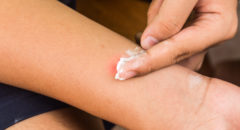
It may sound dramatic, but skin checks save lives. They can also prevent or detect skin cancer early. This is especially important for Blacks who are more prone to certain skin conditions.
While encouraging people to do routine self-exams, the American Academy of Dermatology (AAD) shares some case studies that led to important discoveries.
Richard Danzer, of West Palm Beach, Fla., found a large, painful cyst on his back during a skin self-exam. Dermatologist Dr. Brittany Smirnov examined him, and he was later diagnosed with lung cancer and given lifesaving treatment.
When John Ahearn, of Phoenix, had dark bruising that appeared on his legs, dermatologist Dr. Lindsay Ackerman suspected he might have a serious blood issue. She collaborated with a hematology-oncology specialist who diagnosed Ahearn with leukemia. He is now in remission after a bone marrow transplant.
RELATED: One Key Question Can Help Spot Skin Cancer
The importance of skin self-exams
After noticing changes to a mole on her toe, Yvonne Basil, of Plano, Texas, saw her dermatologist and was diagnosed with melanoma from an in-office biopsy. She is now cancer-free.
"Regular self-skin checks are crucial to identify skin cancer and other skin diseases early," AAD president Dr. Ken Tomecki said in an academy news release. "We encourage everyone to regularly perform skin self-exams to catch any changes early."
MUST SEE: 5 Surprising Things That Increase Your Skin Cancer Risk (It’s Not Just The Sun!)
What to look for during skin self-exams
You can do your own skin checks at home, and then follow up with a dermatologist if you spot something concerning. The academy suggests using the initials A, B, C, D, E during your self-exam.
A is for Asymmetry, when one half of a spot is unlike the other. B is for border, when a spot has an irregular, scalloped or poorly defined border, C is for color, when the spots have color variation from one area to the next. D is for diameter. Melanomas are typically larger than 6 millimeters, which is about the size of a pencil eraser. E is for evolving. The spot looks different from the rest or is changing in size, shape or color.
How to do skin self-exams
The best time to do a skin self-exam is after a bath or shower. To do a skin exam, look at your body in a full-length mirror. Make sure your room is well-lit. You can also enlist the help of a spouse, partner, or close friend or family member to help you with these exams, especially for those hard-to-see areas like your back or scalp. Look at your underarms, forearms and palms. Look at your legs, between toes and at the soles of your feet. Use a hand mirror to examine your neck and scalp, as well as to check your back and buttocks.
If you are examining yourself for the first time, spend time carefully going over the entire surface. Learn the pattern of moles, blemishes, freckles, and other marks on your skin so that you’ll notice any changes next time. If you look at your skin on a regular basis, you'll know what's normal and what's not.
RELATED: Beauty Mark Or Skin Cancer?
What should you look for?
Not all skin cancers look the same. In fact, some skin cancers may show up in a range of shapes and sizes. Certain skin cancers might even look like other skin conditions. Many skin cancers are more common on parts of the body that tend to get more sun, such as the face, head, neck, and arms. But skin cancers can occur anywhere on the body.
Some of the more common ways in which skin cancers can appear include:
- A new, expanding, or changing growth, spot, or bump on the skin
- A sore that bleeds and/or doesn’t heal after several weeks
- A rough or scaly red patch, which might crust or bleed
- A wart-like growth
- A mole (or another spot on the skin) that’s new or changing in size, shape, or color
- A mole with an odd shape, irregular borders, or areas of different colors
RELATED: Dark Skin Isn’t Protection From Deadly Skin Cancer
When to see a doctor
If you notice a spot that is different from others, or that changes, itches or bleeds, you should make an appointment to see a board-certified dermatologist that specializes in skin diseases and can use special tools to look at the area more closely.
Skin cancer is the most common cancer in the United States, with roughly 9,500 people diagnosed every day.
If the doctor suspects you might have skin cancer, he or she will do exams and tests to find out. If you can’t see the doctor right away, it is a good idea to take good close-up photos of the area. This will allow your doctor to see if the area is changing when you do get an appointment.
Usually, the doctor’s first step is to ask about your symptoms, such as when the mark first appeared, if it has changed in appearance, and if it’s painful, itchy, or bleeding. You might also be asked about past exposures to causes of skin cancer (including sunburns and tanning practices) and if you or anyone in your family has had skin cancer. Next, the doctor will examine your skin and take note of the size, shape, color, and texture of the area in question, and if it is bleeding, oozing, or crusting. They may also check the rest of your body for moles and other spots that could be related to skin cancer.
Anything that is deemed suspicious by your doctor will require a closer look. Your doctor may request a sample of skin from that area be removed and looked at under a microscope. This is called a skin biopsy. There are many ways to do a skin biopsy. The doctor will choose one based on the suspected type of skin cancer, where it is on your body, the size of the affected area, and other factors.
For more detailed information on skin biopsies, see Tests for Melanoma Skin Cancer or Tests for Basal and Squamous Cell Skin Cancer.









